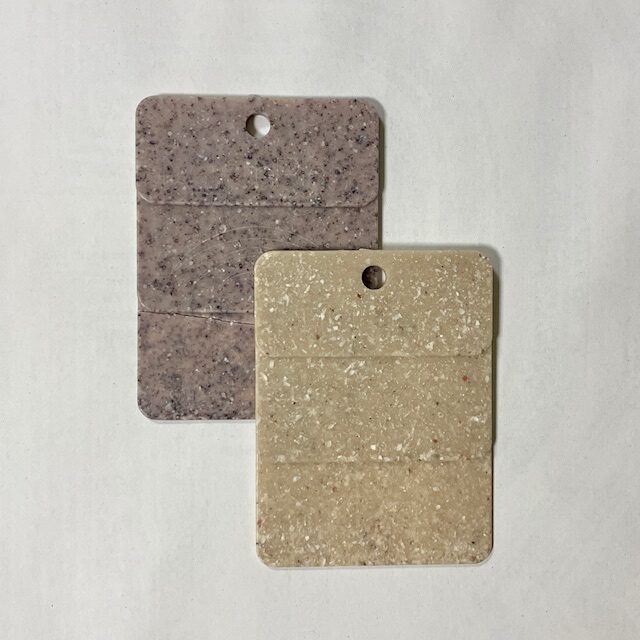Shellfish composites and biocomposites
part 1
part 1








Scallop, oyster and mussel shells, often collected on beaches for their natural beauty, represent tons of shell by-products from production and consumption. In France, this waste is still only partially recycled, mainly for use in construction and public works, as a mineral fertilizer and, to a lesser extent, as animal feed (*).
Many avenues are being explored to transform these by-products into creative and sustainable opportunities, which we are experimenting with in the course of our collection projects or for bespoke creations.
In Part 1, we take a look at the solutions being explored for integrating powdered shells into the manufacture of objects and decorations, from small to large-scale production runs.
The color range
Three of the most popular types of shellfish are used: oysters, mussels and scallops. Depending on the origin of the shells, the season, and the size of the crushed grains, many nuances are possible, and colors may differ slightly between two productions.
Oysters produce light materials ranging from white to beige,
The molds are black, bluish gray, purplish or even shades of brown,
Finally, scallops come in beige-pink.
By combining crushed shells with transparent resins such as epoxy, it is possible to create robust objects with up to 80% recycled material. The manual or semi-automatic molding process is ideal for small production runs of watertight objects (vases, basins) or for outdoor applications (furniture, garden decorations, etc.).
However, the use of non-biodegradable resins to bind the shells raises a question of environmental ethics. We therefore recommend this solution for long-term use only, and are working on ways of improving these materials: for our Scalae lamps and Vaseas vases made from oyster shells, our partner, a committed recycler, uses declassified resins, thus offering a 100% recycled solution.
We also carried out tests on a photophore using a predominantly biosourced (but non-biodegradable) resin with a second partner. The know-how developed by this workshop enables us to design aesthetic, high-quality pieces. Opposite, the test carried out on our Luce photophore.
For creations with a more limited lifespan, such as event decorations, shell-based biocomposites are an excellent alternative. These composites use natural binders, such as animal or algae gelatins.
The result is very solid, water-soluble parts!
The process is suitable for producing flat and low-relief shapes in open molds.
Handcrafted products tend to be produced in small batches, but it is possible to manufacture several thousand units, as on the La Petite Madeleine project, for which we designed the cap and recommended a shell biocomposite and a manufacturer specialized in the creation of these materials.
To take things a step further, these materials can be printed (a process derived from ceramic 3D printing), and this is the subject of research by Bold and Hors studio, among others.
Opposite, zoom in on a piece from the Stereome collection by Hors Studio and Bold, on which we were a partner.
On an industrial scale, powdered shellfish can be added as a mineral filler for injection-molding plastic parts.
Filling will modify the aesthetic and technical properties of these plastics, and reduce the quantity of plastic used. However, the composite plastics obtained will not be recyclable, so in this case it's a good idea to choose a biodegradable polymer, such as PLA or PHA. The result is water-resistant biocomposites that can be industrially biodegraded.
Returning to ancient recipes can also pave the way for modern innovations. For example, the lime used as a binder in ancient concretes was obtained by heating seashells to high temperatures: the resulting materials have stood the test of time!
We initiated research with a partner specializing in the transformation of oyster shells into technical materials, and obtained a kind of marine plaster: photo of a photophore opposite. This solution, still in R&D, is not yet on the market.
Part 2: shell fragments and marine terrazzo.
(*source: Bretagne Environnement).